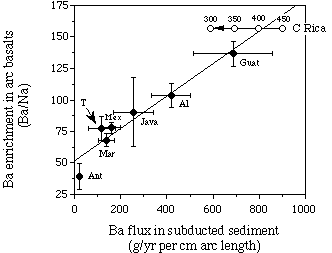170 Scientific Prospectus


Figure 5. Correlation between Ba flux in subducted sediment and Ba enrichment of arc basalts, for the Northern Antilles (Ant), Marianas (Mar), Tonga (T), Mexico (Mex), Java, Aleutians (Al), and Guatemala (Guat) arcs (after Plank and Langmuir, 1993). These types of correlations, which are present for other elements as well, suggest that volcanic output is linked to sediment input in subduction zones. Line is best fit of solid points; vertical error bars are one standard deviation of the mean of volcanoes within each arc; horizontal error bars represent uncertainties in the thickness of sediment being subducted resulting from variable supply, underplating, and erosion (generally +100 m). Input fluxes do not include accreted material, however (see Plank and Langmuir, 1993). Open circles are for the Costa Rica subduction zone. Ba/Na ratios are for Arenal and Rincon volcanoes (data from Carr and Rose, 1987), which are the Costa Rican volcanoes closest to the proposed drilling transect (these northern Costa Rican volcanoes are also chemically distinct from the alkalic southern Costa Rica volcanoes, as noted by Carr et al., 1990). The Ba fluxes for Costa Rica are calculated from the composition and density of the sedimentary column at Site 495, off Guatemala. The arrow at the open circles shows the effect of frontal accretion on the subducted flux, where increasing amounts of the upper hemipelagic mud unit are removed (total meters of sediment subducted as indicated). Fifty meters of offscraping would bring the Ba flux for Costa Rica in line with the global trend. This is an illustrative example of how chemical fluxes might help to constrain accretionary processes. Accurate estimates require better control of the global trend (from improved constraints on the accretionary dynamics at other subduction zones) and Ba data on the incoming sedimentary column off Costa Rica (e.g., proposed Site CR-1).